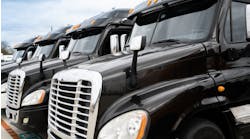Fleet safety has taken on a new look and feel during the COVID-19 pandemic, which has changed freight patterns, reduced some highway congestion and limited safe truck parking across much of the U.S.
With a different kind of summer vacation nearing for many Americans, commercial vehicle drivers have different things to be wary of in 2020. FleetOwner spoke with SmartDrive COO Jason Palmer about this new trucking landscape and how the transportation technology company is helping fleets adapt. This interview has been edited and condensed for clarity.
FleetOwner: What sort of trends have you seen in commercial vehicles during the first months of the COVID-19 pandemic?
Jason Palmer: Our miles driven across our installed base of customers for Class 8 trucks was up by about 15%. We were seeing across our install base of customers on the trucking side an increase in March and April of miles driven. So, we saw they were driving more, but we did see a decrease in collisions overall during that period.
FO: During the first months of the pandemic were the roadways safer or more productive for commercial vehicles?
JP: I think in some respects they were safer. I think the thing that we did start to see go up was what we call “sitting duck” type situations. For some fleets, we were seeing this go up in regions of the country because a lot of the places where trucks would typically park, such as rest areas, were closed. That was creating situations where we were having drivers who are parking places they might not otherwise park. This was bringing about some increased risk. Rest areas that were open were more full, so we were seeing more drivers park on the freeway and walk back to the rest area along the freeway. In talking with different fleets, they were really concerned about the safety of their drivers and trying to work with the state DOTs and others to ensure that their drivers had had places to safely stop their truck, sleep or use the restroom.
FO: What were some ways fleets helped their drivers stay safe?
JP: I think one was they were looking at scheduling routes. They were looking at finding safe places for drivers to park. Where were the safe places for them to refuel? And ensuring they had those appropriate places to stop. There were moves by some departments of transportation and others to open up more facilities for drivers. For example, in Woodland, Wash., (a Portland, Ore., suburb) they opened up a high school that was closed due to coronavirus and made parking and restrooms available for drivers.
There were a variety of things fleets did to ensure their drivers had a safe place to park, but it was definitely a concern. And we started to see it as we were monitoring different safety situations. We were working with fleets to look at how we could help them identify where there were new pockets of risk happening in conjunction with facilities that were locking down.
FO: What are some specifics and other ways you were able to help these fleets?
JP: We were helping some of our customers understand when a truck might be stopped unsafely or when there were road conditions that were potentially unsafe. And then working with targeting and training drivers in operational safety and education around sitting-duck situations. We certainly saw it starting to happen more and escalated that up through fleet management, notifying them that this was an increased situation. They certainly knew the concern — but they weren't able to quantify it. For certain fleets, we were able to help them to quantify what was happening.
We leveraged some of our extended video recordings so we could identify where trucks were stopped for long periods of time. Those videos showed that many times drivers were parked outside of the truck stop or rest area and walking back. We've talked before about the nuclear verdicts that happened from sitting-back-type situations where they're parked on the side of the freeway; that's something that you're working to avoid.
FO: The global pandemic has changed the landscape. It’s almost an entirely different world for commercial drivers. How are fleets using technology during these times to better train drivers and ensure their safety?
JP: There are fleets we are working with, where in the past, they would be working with a driving school graduate with an instructor in the cab doing a checkout with the new driver. We’ve been working with some of our fleets on new checkout programs where the driver is in the cab alone and the instructor is remotely monitoring the performance.
At SmartDrive, we connect to the engine computer, we have video, we have audio, and we can support multiple cameras — not just road-facing but in-cab and cameras down the side of the truck, etc. We’re seeing more fleets now use our expanded system on their training vehicles to be able to have an instructor remotely monitor how the operator's performing and do their driver checkout without having to physically be in the vehicle.
That's one of the ways that we've seen some things change because they're trying working further to ensure the safety of their instructors and their new drivers. This is something we've done on a limited basis in the past, but it has accelerated more recently as people want to be as socially distanced as possible.
FO: Last-mile delivery has had new light shone upon it during this pandemic. What are some other changes to the commercial transportation landscape that SmartDrive has seen?
JP: We've seen a dramatic increase in last-mile and middle-mile delivery, while we've also seen some sectors of our business — particularly vehicles around airports and airport services — decline. Fleets hauling goods in what we call "the middle mile," which is delivering to the service centers, are then using last mile to deliver products to people's houses.
Last mile has seen significant growth in the medium-duty market. [Fleets are] really starting to leverage technology as much as they can to be able to route vehicles to be able to provide proof of delivery, and they're onboarding a tremendous amount of vehicles and drivers. Unlike a Class 8 driver who goes through weeks and months of training, some of these last-mile drivers don't necessarily go through as much training, so they're leveraging systems like ours to help evaluate driver performance. For those drivers and others in the last couple years, we've seen a lot more adoption of driver self-service safety performance management. Having a driver app where the driver can see, for example, where potential speeding incidents are, or where they might not have stopped completely at a stop sign, helps them self-manage and self-coach. We're certainly seeing a lot more of that as we see that mid-market continue to grow.
FO: To what do you attribute the increase in driver self-management? Why are drivers becoming more willing to adapt to and use that technology compared to a few years ago?
JP: Phone applications have become much more robust compared to two or three years ago. I think it took some period of time before the phones that were provided to drivers really could support more rich and robust applications. I think it's a combination of both: Some drivers didn't have phones or weren't issued a company phone or their older phones weren't capable of really running robust driver apps.
Now, I think we're seeing in the telematics market better devices for drivers such as tablets that have rich multimedia capabilities to run these applications. We're seeing much more of that with larger fleets. And we're seeing them develop apps for their drivers for overall performance — not just safety performance — but performance and efficiency. They're building those apps into tablets and phones for the drivers. We've really seen that accelerate over the last couple of years. Fleets are investing a lot in building applications for their drivers and they're seeing that as a competitive advantage by making their drivers more efficient. So we're investing in building and deploying apps.
FO: How do you see this helping reduce risky behaviors compared to the last decade?
JP: If you go back two, three years, a lot of fleets would rely on the manager working with the driver with face-to-face coaching on safety and driver performance. Maybe once a quarter, they would provide reports to the driver. If we go back to three years ago, most of it was paper reports. So I don't know that that was as effective as what we're seeing with drivers who have a driver app where they can get an alert on their phone. They can look at what their performance is in a more convenient way. Younger drivers, especially, are used to getting performance in an app on their phone versus getting a paper scorecard that they see in their mailbox once a month. The mobile app gives them access to information in real time, so they're able to address things much more quickly.
FO: What are some of the riskiest driving behaviors these days that SmartDrive is keeping an eye on?
JP: For commercial drivers, most of what they're dealing with is their environment. The No. 1 thing that we work with fleets on is defensive driving skills. You're having to deal with all these things that are happening out on the road. We're continuing to see, certainly during this COVID-19 timeframe, non-commercial vehicles operating very fast when there's less traffic and driving faster than they might typically. So it's very much the defensive driving skills to start out with.
The critical skills that drivers are working on when it comes to defensive driving are: proper following distance, ensuring they've got enough room to react to the vehicle in front of them and things that are happening around them; ensuring that they've got an out should something happen in front where a vehicle stops suddenly or swerves in front of them; being able to react to that situation and maneuver while dealing with distracted drivers who may veer into their trailer or who are not paying attention as much as they should.
And for fleets that we work with, fatigue is always a primary concern. It's not a high-frequency rate of collisions, but if fatigue does set in, or it's an issue with a driver, it's one that we want to ensure we're addressing quickly.
FO: We’re not even halfway through 2020 yet and this year has already proven to be a year unlike any other. Are you looking at fleet safety differently right now than you expected to at the start of the year?
JP: As we look at the Class 8 space, collisions overall have reduced, although we still have some severe and fatal collisions. For our customers, the rates that we see in collisions have been down the last few months while the miles driven have gone up. It'll be interesting to see as we close out June what it starts to look like. We're seeing traffic patterns and other things start to return back to a kind of pre-COVID-19 state. It'll be interesting to see how that starts to crank up.
We’ve certainly been spending more time on sitting-duck situations because of regular parking areas being closed. Whereas, we might have spent more time on distracted driving or following distance and other types of behavior more associated with congested roadways.
FO: Do you anticipate this summer to be different than the typical American summer on the roadways?
JP: I was on a call with a safety group last week and one of the things they were expressing concern about was that we are going to see more people taking road trips this summer for vacation. Will those who might otherwise have flown to Mexico or Europe or other places opt for a road trip instead? If that’s the case, there could be more people on freeways and roadways than there might have been in the past. It will be interesting to see, but it’s hard to predict. I think we'll definitely see differences in how people vacation this summer, which might create more road traffic in some areas than it otherwise would have.




